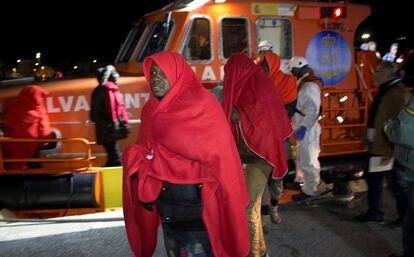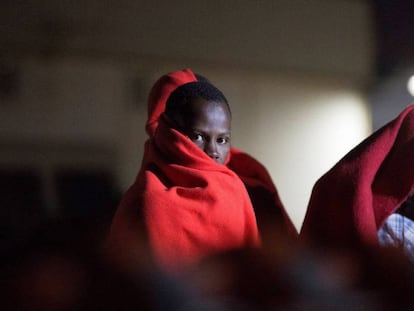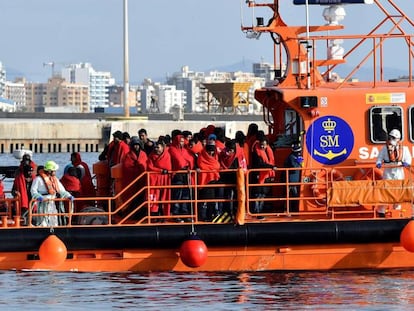Nearly half of migrants who arrive in Spain via Africa report violence on the journey
According to a study by the International Organization for Migration, Morocco is the country where immigrants suffer the most

The dangers of the migration route to Spain are not limited to the danger of crossing the Strait of Gibraltar or the western Mediterranean in unstable boats. The moment they leave home, migrants are subjected to exploitation, violence and abuse for thousands of kilometers.
According to a study by the International Organization for Migration (IOM), based on 1,341 interviews with migrants and refugees, 48% suffered at least one out of the five indicators that the organization links to human trafficking, exploitation and abuse. Almost half of the migrants who arrived in Spain in the second half of 2017 and 2018 reported at least one of the following: physical violence, kidnapping, forced labor, arranged marriage offers and jobs in which they weren’t paid what they were owed.
In 46% of cases, migrants reported they had suffered the most in Morocco
The country where respondents suffered the most violence was Morocco, Spain’s main partner in controlling irregular immigration. In 46% of cases, migrants stated that they had suffered the most in the North African country. “The abuses are a big source of concern for the IOM” regardless of where it happens, explains the organization, which has noticed in other studies that “a higher frequency of abuse often occurs in the last countries before reaching Europe.”
Physical abuse is the most common aggression and was mentioned by 41% of the interviewees. This violence is usually related to kidnappings perpetrated by nomadic groups in desert areas, as well as beatings in larger cities aimed at stealing migrants’ belongings, and assaults by human traffickers in boarding areas in Algeria and in northern Morocco. According to the IOM report, 8% of migrants reported witnessing threats of sexual violence, while 2,7% saw people being approached with offers of money in exchange for blood and organs.
Motivations vary based on gender: 44% of the men migrated for economic reasons, while 58% of women did so because of personal violence
While men who are traveling alone are most commonly attacked, violent acts can also take place against migrants traveling in groups or with their families. The IOM states that traveling with a family only guarantees a certain amount of protection for women because the men who migrate with family members run a higher risk. The average victim is from Cameroon, Gambia and Guinea and is 23.5 years old.
Migrants from Algeria and Morocco are the least susceptible to violence because of their proximity to Europe. “The length of the journey is often associated with a lack of resources at the last stage, when it becomes necessary to find a job and to earn money to continue the journey. These circumstances obviously increase the migrants’ vulnerability to abuse and exploitation,” says the IOM. Out of the number of migrants who reported abuse, 63% spent more than a year trying to reach Europe.
Who migrates, and why?
The IOM report outlines some of the characteristics of those who migrate and their reasons for doing so. Almost half of the migrants interviewed were unemployed. The interviews also revealed that the price of the journey to Spain hovers around €900, a number which 43% of the migrants paid, while 4% paid €4,500. On the other hand, 8% reported not having paid anything. This is often the case with Moroccans and Algerians who are able to leave their countries without help from the smugglers. About 38% of those interviewed spent over a year on the journey.
Regarding the motivations behind migration, 41% mentioned that it was for economic reasons, while 32% stated it was due to personal violence, which includes gender violence, family abuse, genital mutilation, family opposition to inter-religious marriages, conflicts over inheritances or persecution because of sexual orientation or gender identity. On the other hand, 15% said they migrated because of violent conflicts and war. Motivations vary based on gender, as 44% of the men interviewed migrated for economic reasons, while 58% of women did so because of personal violence.
At the start of their journey, Spain was the primary destination for 51% of men and 53% of women, followed by France and Europe in general. These percentages grew at the time that the migrants were interviewed about their final destination – two-thirds ended up choosing Spain. “The increase is due to the fact that reaching other countries in Europe turns out to be harder than they had expected at the beginning of their journey,” states the IOM report.
English version by Asia London Palomba.
Tu suscripción se está usando en otro dispositivo
¿Quieres añadir otro usuario a tu suscripción?
Si continúas leyendo en este dispositivo, no se podrá leer en el otro.
FlechaTu suscripción se está usando en otro dispositivo y solo puedes acceder a EL PAÍS desde un dispositivo a la vez.
Si quieres compartir tu cuenta, cambia tu suscripción a la modalidad Premium, así podrás añadir otro usuario. Cada uno accederá con su propia cuenta de email, lo que os permitirá personalizar vuestra experiencia en EL PAÍS.
¿Tienes una suscripción de empresa? Accede aquí para contratar más cuentas.
En el caso de no saber quién está usando tu cuenta, te recomendamos cambiar tu contraseña aquí.
Si decides continuar compartiendo tu cuenta, este mensaje se mostrará en tu dispositivo y en el de la otra persona que está usando tu cuenta de forma indefinida, afectando a tu experiencia de lectura. Puedes consultar aquí los términos y condiciones de la suscripción digital.
More information
Archived In
Últimas noticias
Maduro pleads not guilty before the federal court in New York: ‘I am still the president of Venezuela’
A new test can detect Alzheimer’s from a finger prick
UN team enters Sudanese city of El Fasher after paramilitary massacre: ‘It’s like a ghost town’
A recipe for resistance: Indigenous peoples politicize their struggles from the kitchen
Most viewed
- Gilles Lipovetsky: ‘If you want to live better and fall in love, take Prozac, don’t look to philosophy’
- Alain Aspect, Nobel laureate in physics: ‘Einstein was so smart that he would have had to recognize quantum entanglement’
- Alvin Hellerstein, a 92-year-old judge appointed by Bill Clinton, to preside over Maduro’s trial in New York
- Why oil has been at the center of Venezuela-US conflicts for decades
- Cuba confirms death of 32 of its citizens in the US attack against Venezuela











































